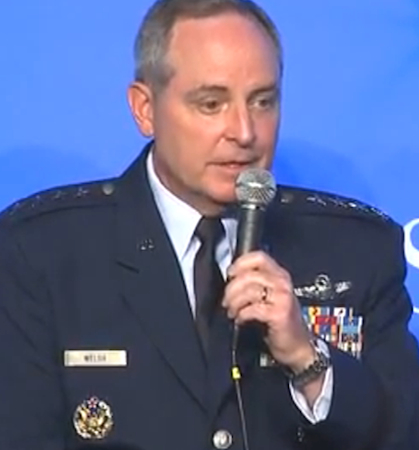 The demands on the Air Force will not let up even after the US military’s drawdown in Afghanistan, said Chief of Staff Gen. Mark Welsh. “We are not going to get less busy,” he said during a talk on July 17 at the annual Aspen Institute Security Forum in Aspen, Colo. “Our Air Force does an awful lot of stuff behind the curtain that people don’t really see,” said Welsh in emphasizing the point. There will still be the need for intelligence, surveillance, and reconnaissance missions all over the world, and the Air Force will still be performing an airlift mission “every 90 seconds, every hour of every day,” said Welsh. Plus, many thousands of airmen will operate satellites, protect cyber networks, and maintain the readiness of the nation’s ICBMs and nuclear-capable bombers, among the many missions that airmen will perform each day, he said. In fact, about 220,000 airmen in all—about 43 percent of the Air Force’s uniformed force—are committed to supporting combatant command activities every day from their home station, said Welsh. “It’s a different mode than the other services have, and, as a result, most people don’t really understand it,” he said. (Aspen Institute webpage of event and webpage with video of event) (See also AFPS report by Claudette Roulo)
The demands on the Air Force will not let up even after the US military’s drawdown in Afghanistan, said Chief of Staff Gen. Mark Welsh. “We are not going to get less busy,” he said during a talk on July 17 at the annual Aspen Institute Security Forum in Aspen, Colo. “Our Air Force does an awful lot of stuff behind the curtain that people don’t really see,” said Welsh in emphasizing the point. There will still be the need for intelligence, surveillance, and reconnaissance missions all over the world, and the Air Force will still be performing an airlift mission “every 90 seconds, every hour of every day,” said Welsh. Plus, many thousands of airmen will operate satellites, protect cyber networks, and maintain the readiness of the nation’s ICBMs and nuclear-capable bombers, among the many missions that airmen will perform each day, he said. In fact, about 220,000 airmen in all—about 43 percent of the Air Force’s uniformed force—are committed to supporting combatant command activities every day from their home station, said Welsh. “It’s a different mode than the other services have, and, as a result, most people don’t really understand it,” he said. (Aspen Institute webpage of event and webpage with video of event) (See also AFPS report by Claudette Roulo)
House, Senate Unveil Competing Proposals for 2026 Budget
July 11, 2025
Lawmakers from the House and Senate laid out competing versions of the annual defense policy bill on July 11, with vastly different potential outcomes for some of the Air Force’s most embattled programs.